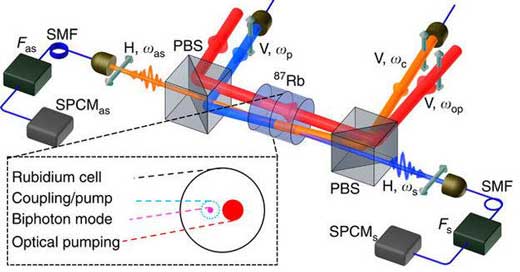| Posted: Oct 19, 2016 |
Subnatural-linewidth biphotons generated from a Doppler-broadened hot atomic vapor cell
(Nanowerk News) Entangled photon pairs, termed as biphotons, have been the benchmark tool for experimental quantum optics. The quantum-network protocols based on photon-atom interfaces have stimulated a great demand for single photons with bandwidth comparable to or narrower than the atomic natural linewidth. In the past decade, laser-cooled atoms have often been used for producing such biphotons, but the apparatus is too large and complicated for engineering.
|
|
Led by Shengwang Du, Associate professor of physics at the Hong Kong University of Science and Technology (HKUST), a group of scientists were able to produce subnatural-linewidth (<6MHz) biphotons from a Doppler-broadened (530 MHz) hot atomic vapour cell. This method marks a significant breakthrough in the field, as it greatly simplifies production process of narrowband biphotons.
|
 |
| Experimental configuration for generating narrowband entangled photon pairs from a hot Rb87 vapor cell. (Image: Department of Physics Division of Biomedical Engineering, The Hong Kong University of Science and Technology)
|
|
Their findings were published in Nature Communications ("Subnatural-linewidth biphotons from a Doppler-broadened hot atomic vapour cell").
|
|
"Subnatural-linewidth biphotons with controllable waveforms have used to be produced from spontaneous four-wave mixing in cold atoms at a temperature of about 10 µK assisted with electromagnetically induced transparency or cavity," said Du. "But such systems require expert knowledge in laser cooling and trapping. A cold-atom apparatus is not only expensive, but also large and complicated in its vacuum-optical-electronic-mechanical configuration. Moreover, operating cold atoms for producing paired photons requires a complex timing control."
|
|
"In our study, we find a novel way to use a hot paraffin-coated 87Rb vapour cell at 63°C to successfully produce biphotons with controllable bandwidth (1.9-3.2MHz) and coherence time (47-94ns). This is the best result in the world so far for generating narrowband biphotons from a hot vapor cell." Du continued.
|
|
The two key elements to make narrowband biphoton generation feasible are the paraffin coating and the spatially separated optical pumping. The long ground-state coherence time preserved by the paraffin coating enables efficient optical pumping for the flying atoms, which is spatially separated from the biphoton generation volume.
|
|
Du said, "Hot atomic vapour cell is simple in configuration, operation and maintenance, and it is a continuous biphoton source. This result may lead towards miniature narrowband biphoton sources for practical quantum applications and engineering."
|

